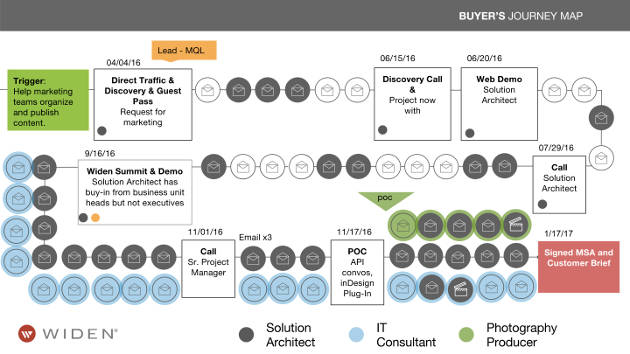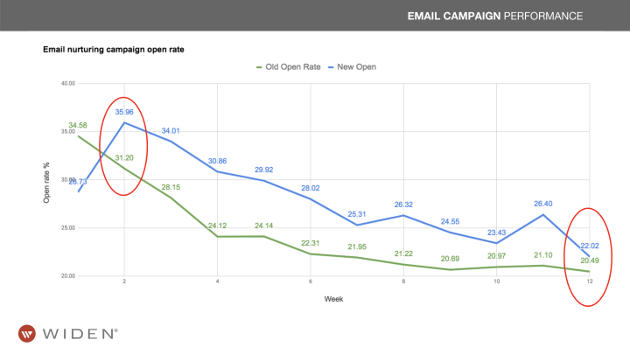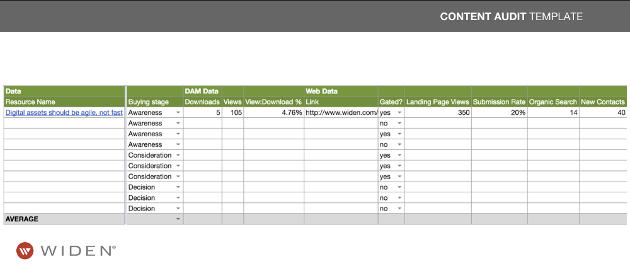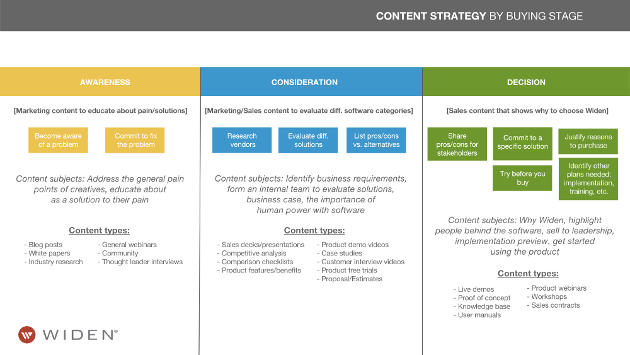Let's pretend your marketing team survived a plane crash and washed ashore on the warm sand of a Pacific island. You have no map, compass, or GPS. You're not sure where to find fresh water, kindling, or shelter. As you trudge uphill into the jungle interior, one of your companions asks, "Are you sure we're going the right way?"
How would you know?! What's the "right" direction when you're lost on an island?
The situation reminds you of all the content your team was cranking out before your fateful trip. The content read well. It looked sharp. Sometimes it racked up LinkedIn likes...
But was the content heading in the right direction? How would you know?
My team at Widen recently explored our jungle island of content data—safely from Madison, Wisconsin—to find a right direction. When visitors enter an email address to download content from our website, that action kicks off a multiweek email nurture campaign with one email per week. But, like many B2B tech marketers, we support a long sales cycle, and knew we could do better with our nurture campaign. So my teammates Nina Brakel-Schutt and Nate Holmes led a content audit.
Initially, we wanted to see what our data says—as if 0s and 1s would tell us where to go. But there's way too much data to review! And its interpretation is only as good as our questions.
We devised a new content auditing approach using data from CRM, marketing automation, and digital asset management (DAM) tools. Other stacks would work too. That content audit saved our content and email marketing strategy from perishing on a desert island—and it might save yours, too.
1. Form your question
Form a question that challenges your most entrenched assumptions. For example, B2B marketers take pride in understanding and serving their buyers. No marketer brags, "We have no idea who's buying our stuff and why!" Lead with a question such as, "Who are our buyers and what content would answer their questions throughout the buying experience?"
Start the inquiry by mapping the journey of the last 10 customers you signed. Here's what one of our maps looked like:

Let's note a few things:
- First, the buying cycle was longer and more unpredictable than we had thought. We had content queued up for 12 weeks, but the journey lasted nine months.
- Second, different buyers jumped in at one month, six months, and eight months, so we couldn't have delivered the right content at the right time. The photography producer would have received content on the basics of DAM just before signing the contract.
- Third, because the content was static and directed toward marketers, the buyers who are IT folks had to search or ask for technical content if they wanted it.
Across prospective buyers, the open rates on this email campaign declined by one-third between the first and twelfth week. That held true even after we improved performance with new creative and messaging (reflected in the blue trendline):

Declining open rates certainly weren't the right direction. We had to re-examine what we delivered, whom we delivered it to, and why.
2. Uncover your content
The next step is to uncover what content you use and how it performs. For a given campaign, paste the names of each piece of content (with hyperlinks) in a spreadsheet in chronological order. Then, categorize each piece of content by its stage in the buyer journey: awareness, consideration, or decision.
Let's unpack those three labels. At the awareness stage, buyers try to define their challenge or opportunity. At the consideration stage, buyers have distinct goals and explore how to achieve them. By the decision stage, the buyer has chosen a category of solutions and evaluates them to find the best fit. The driving question flows from why to how to what.
After categorizing the content by journey stage, add your engagement data. That could include downloads, views, organic searches, gated (y/n), social shares—it depends on your marketing stack. A template might look like this:

After prepping the spreadsheet, you're ready to investigate whether your content met buyers' needs.
3. Evaluate strengths and weaknesses
In a mature B2B martech stack, you generally evaluate engagement metrics such as views, social shares, organic searches, and downloads. Those metrics may capture an audience's reaction to content, but they miss other characteristics.
Everyone in our email campaign received the same content at the same pace. Thus, the winners in the spreadsheet had appeal across personas (more on those soon). However, it's extremely hard to pin down cause and effect in content data. The top-performing pieces seemed to have self-explanatory value, but maybe that had nothing to do with their success.
When evaluating content, try to capture qualitative attributes in numbers. Using the engagement metrics and your own reading of the content, you can rank the following on a 1-5 scale or use letter grades. Add these to the spreadsheet:
- Brand. Review the writing style for voice, tone, and messaging. Check the visual expression for photography style, colors, and fonts. How well do they reflect your brand?
- Clarity. Do the writing and layout present the information clearly and concisely?
- Accuracy. Does your content reflect the current state of your industry and company? Is the information accurate and up-to-date?
- Business value. How closely does the content relate to your business objectives?
- Utility. How much value does it provide to the reader?
Look for patterns. Maybe your best content ranks high on utility yet seems off-brand. Perhaps clarity separates your best-performing pieces from the worst. Those patterns inform the content strategy you'll create in the next step.
4. Update as needed
The content that excelled should continue to reach every persona. Update it as needed and keep it in play. However, it's time to replace the content that performed poorly.
Personas will help you find a right direction for the new content you'll use. Personas are caricatures of your ideal customers or target audiences. They are like maps in that they're not "reality." By using personas we try to anticipate who buyers are and how they participate in the buying process so we can gear content to their needs.
My team used to focus on three personas—Creative, IT, and Marketing—but they were too broad. We extrapolated eight personas from those three, but creating tailored content for eight personas was too burdensome for a company our size. So we started our "persona-off" with this data (gathered from marketing automation, CRM, and DAM tools):
- Current personas visiting our website
- Job titles among those going through our buying process
- Our primary point of contact at each buyer organization (name and title)
- Average customer close time
- Content fed by Sales versus content buyers consume on their own
From that data, we identified the four most valuable personas. We then interviewed people in the buying process about their roles, goals, and pain points. We had two objectives: compare reality to our personas, and identify what content each persona would want. We asked questions about the following:
- Work goals
- Daily tasks and responsibilities
- Challenges at work
- Favorite information sources
- Personality traits related to our products and services
The interviews gave us the material to create empathetic profiles and content strategies for each persona. Each persona profile covers six points and answers each point with two to six bullets:
- Who are they?
- How do they find us?
- What do they want to know?
- What don't they want?
- What are their pain points?
- Why do they buy from us?
From that information, we created a content strategy for each persona. The template is divided by stage in the buying journey and looks like this:

* * *
Our content audit has answered who the buyers are and what questions content should answer throughout the buying experience.
Is our content heading in the right direction? We now have a way to check before we invest time and resources in creation.
The audit prepared us to (re)create email nurturing campaigns for each persona and start them wherever the buyer stands in the journey.
Rescue yourself
If your content strategy feels lost, use a similar content audit to find a right direction (there's never just one).
"Is our content heading in the right direction?" will become easier to answer over time. In the first round, you might overhaul personas or create them from scratch. In subsequent rounds, once you know the island terrain, look for new shortcuts and hidden gems. Try to get lost again (safely, in your office).









